Comet 252P Zooms North, BA14 Grows Tail
Splintered comet duo 252P/LINEAR and P/2016 BA14 liven up both dusk and dawn this week. Naked-eye 252P finally debuts in northern skies, while BA14 makes a beeline through the Big Dipper.
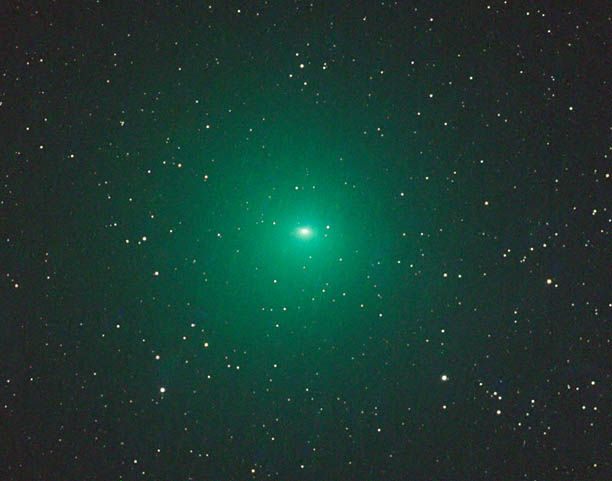
Comet 252P/LINEAR displays a vivid green coma from fluorescing gas in this photo taken on March 18, 2016, three days before perigee when the comet passed 3.3 million miles (5.3 million kilometers) from Earth.
Gerald Rhemann
Gerald Rhemann
Get your ticket ready, the train's a comin'. Comet 252P/LINEAR, having passed closest to Earth on Monday, continues its dash north, finally poking above the horizon for the southern United States this week. Tomorrow morning (March 24th), skywatchers in the southern states can spot it just below the tail of Scorpius (nearly due south) shortly before the start of dawn.

Comet 252P/LINEAR passes by the Large Magellanic Cloud (small, diffuse object directly above it) on March 18, 2016.
Chris Wyatt
Chris Wyatt
The following morning, it might be glimpsed as far north as Minnesota under excellent skies. By Saturday (March 26th), the entire United States and southern Canada will be in the clear with 252P nearly 10–20° high, depending upon your latitude.
If you're a beginner and don't quite know where to look, find a location with a wide-open horizon to the south and face that direction about two hours before sunrise. About 1/3 the way up from the horizon you'll see three bright "stars" arranged in a triangle. The top two are the planets Saturn and Mars, the bottom is the star Antares (see map below).
Both Mars and Antares have a reddish-orange color. Using Antares as a pointer, glide your gaze down the sloping tail of Scorpius until you reach the end, marked by the bright star, Lambda (λ) Scorpii (Shaula). Use this star as a stepping stone to reach the comet.
Recent reports from Southern Hemisphere skywatchers peg 252P at about magnitude +5.0, not a bright object but certainly naked-eye under good conditions.
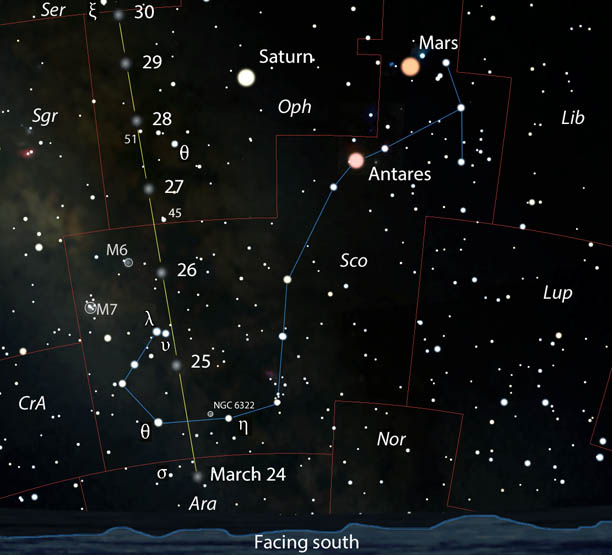
This map shows the daily position of 252P/LINEAR at 5:30 a.m. local daylight time for the Americas. Stars are shown to magnitude +6.5; sky for latitude 40° North. The comet passes just 2.4° west of M6, the Butterfly Cluster, on March 26th. Click for a larger version.
Stellarium / Diagram: Bob King
Stellarium / Diagram: Bob King
On March 18th, comet-watcher Michael Mattiazzo of Australia described it as 50′ across with a weakly condensed, somewhat brighter center. Glowing at magnitude +4.8, he spotted it with the naked eye, adding:
"Back in early March, when I found it a difficult object in an 8-inch scope, I was questioning whether 252P would even reach its predicted peak of magnitude 10. Never had I expected it to reach naked-eye brightness!"
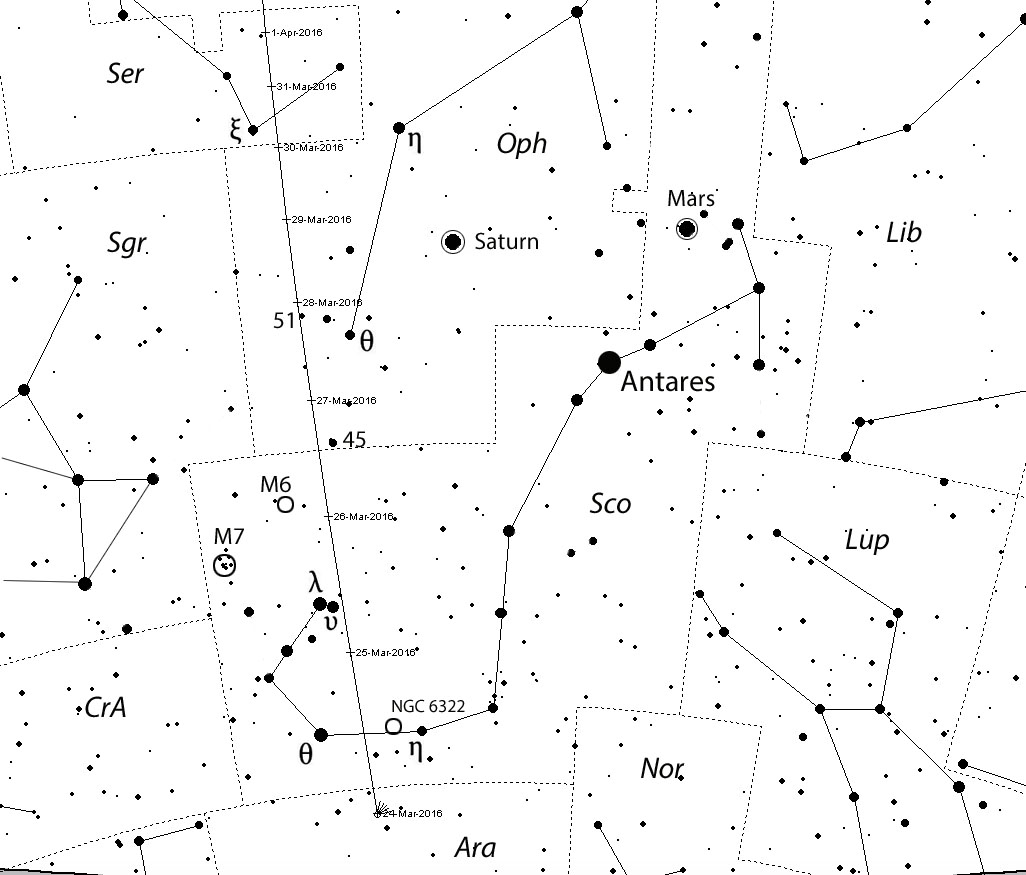
Prefer a B&W reversed chart? Try this one, which shows the daily positions of 252P at the same time as the one above. Stars to magnitude +6.5.
Chris Marriott's SkyMap
Chris Marriott's SkyMap
Another Australian observer, Chris Wyatt, found it slightly brighter at +4.5, very diffuse, and about 40′ across through 7×50 binoculars on March 21st. The comet's sudden rise to prominence may be due to several factors: its close flyby of Earth just a week after reaching perihelion on March 15th certainly played a role, but the steep increase was unexpected and may point to an eruption on the comet that exposed fresh ice and dust to the Sun. Time exposure photos show a bloated ball of green mist from fluorescing diatomic carbon, a carbon vapor "exhaled" by active comets and set to glow by solar UV light.
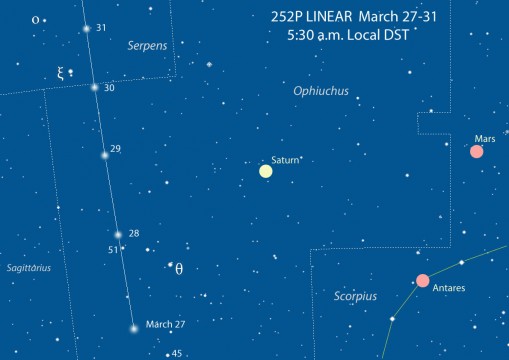
If Comet 252P/LINEAR is fainter than expected or fades quickly, use this deeper and enlarged chart that shows stars to magnitude +8. The view is facing south around 5:30 a.m. local daylight saving time. Saturn or Theta Ophiuchi are good places to begin your star-hop to the comet.
Chris Marriott's SkyMap
Chris Marriott's SkyMap
So that's the good news. Ready for the bad? In one of the finest examples of wretched timing, a bright waning gibbous Moon takes up residence in the morning sky this week. Given 252P's diffuse appearance, most of us may need binoculars to coax it from the moonlight-soaked sky. Even worse, the Moon draws closer and closer to the comet through March 30th. Not until March 31–April 1st, when 252P/LINEAR is expected to fade to magnitude +6–7, will we finally get to see it in a dark sky.
Let's hope the comet hangs in there. Occasionally, a periodic comet will exhibit perihelion asymmetry, when its decline in brightness due to increasing distance from the Earth and Sun is delayed. No one's sure why this happens, but it may have to do with solar heat still working its way through the comet's nucleus, setting off additional waves of vaporization and dust outflow. If this happens with 252P, there's still a chance it will be faintly visible with the naked eye when the Moon departs.

On March 20, 2016, Comet P/2016 BA14 still appeared stellar but had brightened to magnitude +13. The comet is likely a fragment of 252P/LINEAR that broke away and now travels on a separate but very similar orbit.
Gianluca Masi
Gianluca Masi
Meanwhile, the possibly related comet, P/2016 BA14 (Pan-STARRS), remains faint and almost coma-less. Photographs show a very small, nearly stellar object. Another Australian comet watcher, Paul Camilleri, used a 16-inch (0.41-meter) Dob at 260× to track the comet when it passed near a bright star on the 22nd. He described it as "stellar in appearance, magnitude +12.8; motion was such that you could watch the star-like comet move against the moonlit background sky and field stars."
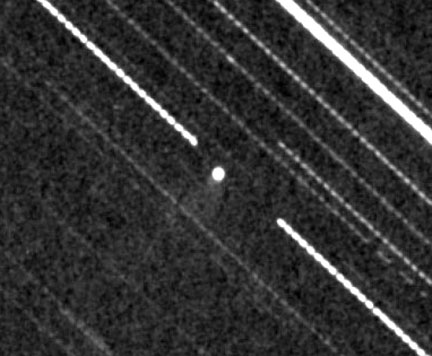
Comet P/2016 BA14 has been showing weak activity in photos taken this week. In this image made on March 22, a short tail extends southeast of the stellar coma.
Alfons Diepvens
Alfons Diepvens
On March 22nd, Belgian amateur Alfons Diepvens succeeded in photographing an extremely faint, 1′-long tail pointing southeast of the stellar coma using a 7.9-inch (20 cm) refractor. Other amateurs have also noted weak activity despite the bright moonlight of recent nights.
The comet's closest approach occurred yesterday (March 22nd), but it's still loping across the sky at practically a constellation a day. To get a sense of its movement, check out this animation by Greg Hogan of Kathleen, Georgia. The tracking map below shows BA14's hourly positions beginning at 0 UT March 24th (7 p.m. CDT March 23rd) through March 26th.
I suspect parallax may shift the comet's track just a bit as viewed from various locations because of its proximity to Earth. To plot a custom path for your city, go to the Minor Planet &Comet Ephemeris Service and type in P/2016 BA14 in the big, empty box. Next, scroll down and enter your latitude and longitude, then select your sky-charting program from the list near the bottom and click on Get Ephemerides/HTML page. Save the file of orbital element file that pops up and place it (or copy and paste) into the appropriate folder in your program. Open your program, select the comet and create a chart.
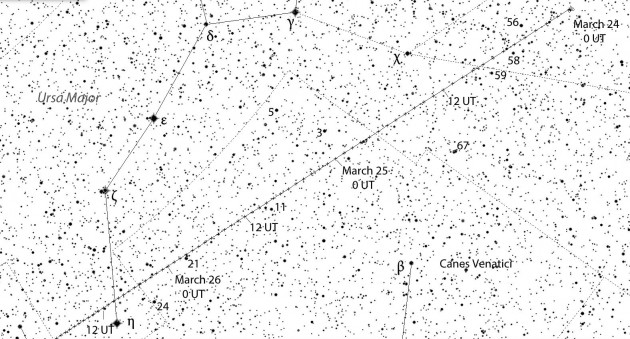
This map plots Comet P/2016 BA14's hourly progress starting on March 24th 0 UT (upper right) through March 26th. I've labeled brighter and helpful guide stars along the comet's path. Stars shown to magnitude +11. Click to enlarge and print out for use at the telescope.
Chris Marriott's SkyMap
Chris Marriott's SkyMap
The comet will undoubtedly prove challenging, but on the plus side, its fast movement will set it apart from everything else. When seeking it, focus on a brighter star the comet is expected to pass and then lie in wait for it to enter the view. If BA14 remains bright enough to spot in amateur scopes beyond the weekend, I'll create a new map and post it to the blog on Sunday.
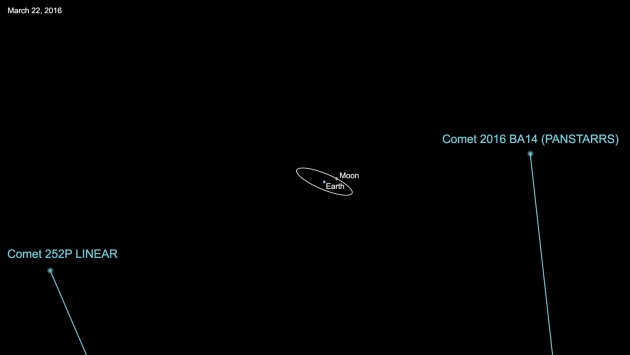
Comet 252P/LINEAR safely flew past Earth on March 21, 2016, at a range of about 3.3 million miles (5.2 million kilometers). The following day, comet P/2016 BA14 did the same but at a distance of about 2.2 million miles (3.5 million kilometers), in what turned out to be the third closest comet observed to approach Earth after Lexell's Comet (1770) and 55P/Tempel-Tuttle (1366).
NASA / JPL-Caltech
NASA / JPL-Caltech
Both of these objects are very small. 252P is approximately 750 feet (230 meters) wide, or several hundred feet smaller than the lake freighters and cargo ships that ply the ports of the U.S. Great Lakes. BA14 is only about half as big.
A New Meteor Shower?
Peter Jenniskens of the SETI Institute and Jeremie Vaubaillon of the Institut Mécanique Céleste et de Calcul des Éphémérides (Paris), report that in the wake of 252P's close approach on March 21st, a new meteor shower may radiate from the constellation Lepus (below Orion) on March 28–29th. The shower, predicted to be weak, would originate from a diffuse cloud of meteoroids released by the comet between 1894 and 1926. Keep watch early in the evening before Lepus sinks too low.
A potential meteor shower, two fast comets, and a dwindling moon — our Easter baskets are quickly filling up!
No comments:
Post a Comment